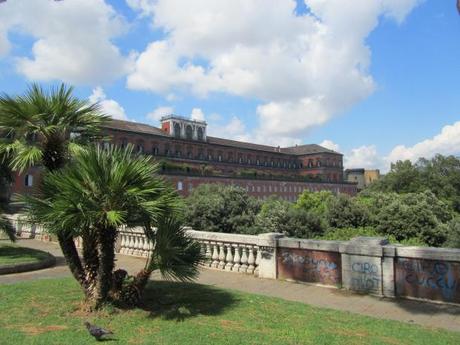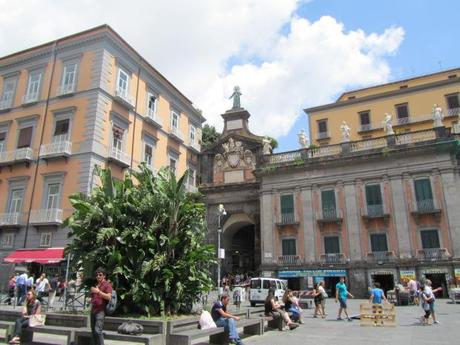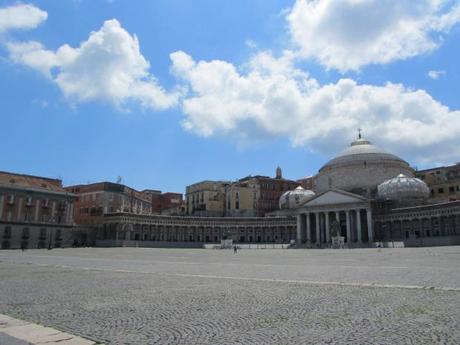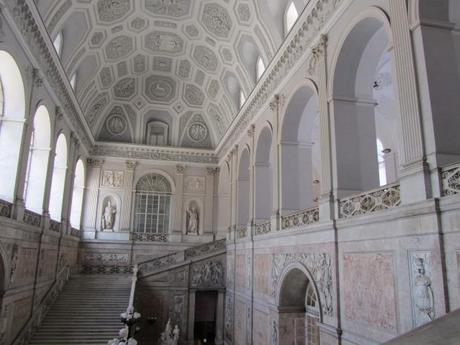

‘See Naples and die’ said Goethe, after experiencing the glories of Naples in the Golden days of the Bourbon Kings. Naples was once the wealthiest and most beautiful city in Italy, and I couldn’t wait to see it. I imagined splendour, pomp, gilding and streetscapes so architecturally perfect that they would send me into raptures. Unfortunately, my first impression was anything but. On disembarking the train at the Piazza Garibaldi, I couldn’t believe my eyes. The building of the train station had obliterated this clearly once majestic square, and all I could see were seedy shops and crumbling stucco. Where was the fine city I had been promised? Walking through the streets to the Duomo, the dilapidation of the architecture all around me became even more pronounced. Glimpses of alleyways filled with hanging washing and mopeds were all very quintessentially Italian, but they weren’t particularly gorgeous. The Duomo, tricky to find, nestled amidst a huddle of flaking apartment buildings and shops, was breathtakingly beautiful inside, but on the outside, it was rather lost in its insalubrious surroundings. I felt very disappointed.


However, as I walked on, through the maze of ochred buildings with their wrought iron balconies, beautiful french windows, peeling shutters and decorative ceramic tiles, and caught glimpses of intriguing courtyards and alleyways hidden behind arches, I began to fall in love. Then, when I found the long main shopping street, with its pretty piazzas, side streets that climbed steeply up the cliffside, fantastic art deco buildings and glimpses of the sea beyond its shops, I was able to capture the essence of what made this such a gorgeous city. The piece de la resistance, however, was yet to come; at the end of the main street is Piazza del Plebisicito, home of the enormous Palazzo Reale, former palace of the King and Queen of Naples, which dangles over a cliff edge with incredible views across the Bay of Naples to Mount Vesuvius. This Piazza, sadly covered in scaffolding so not a great photo opportunity, is truly beautiful, and I can only imagine what it looked like back in the days of Naples’ eminence. The Palazzo Reale is just as opulent inside as out, and in true Italian style, it is a bargain to visit; just 4 euros to wander the marble and gilded halls, the sumptuous state rooms and galleries, and the formal gardens overlooking the sea. It was the highlight of my visit. I wish I had have had more time to explore; I wanted to get to the archaelogical museum where most of the relics from Pompeii are on display, but it was too hot and too far to walk, so I contented myself with the Palazzo as my token nod to culture for the day. Getting the ferry back to Sorrento was the cherry on the top of a wonderful cake; the view of Naples from the sea, blurring its dilapidation into finery once more, is priceless. It was only later that I found out how badly Naples was bombed during the war, which explains the state of many of the buildings. An astonishing 20,000 civilians died from aerial bombing.


Later in the week, I hopped back on the wonderfully named Circumvesuviana train from Sorrento to Ercolano Scavi, which is home to the ancient town of Herculaneum, unearthed from volcanic mud mere decades ago to reveal the Roman civilization trapped at the moment of Vesuvius’ famous eruption. Unlike Pompeii, which is absolutely massive and crowded with tourists, Herculaneum is very compact, nestled amidst the existing city of Ercolano, and not as well known, so much quieter. I couldn’t bear the thought of wandering for miles around Pompeii amidst masses of crowds in the considerable heat, so I decided to visit Herculaneum instead, for a snapshot of what life was like in AD79. I found it fascinating to see how much remains; shop signs hang from walls, wooden doors and shutters separate rooms, the most intricate mosaics and paintings decorate walls and floors, and in the baths, the shelves to put clothes and towels look like they were built only yesterday. It was eerie and rather thought provoking to think that this was a world busy and bustling with people, living lives not dissimilar to ours nearly 2000 years ago. The footprints they left behind show us that we, like them, will soon be ancient history, our customs and habits discussed by people far removed from us in time, and yet in spirit, still essentially the same. I have never before been in a place that showed so clearly how little separates us from the past, and I found it an absolutely brilliant, illuminating experience. If I go back again, I’d like to visit Pompeii, but if you are in the area and it really is too hot to cope with too much walking, Herculaneum is a much more manageable alternative.
